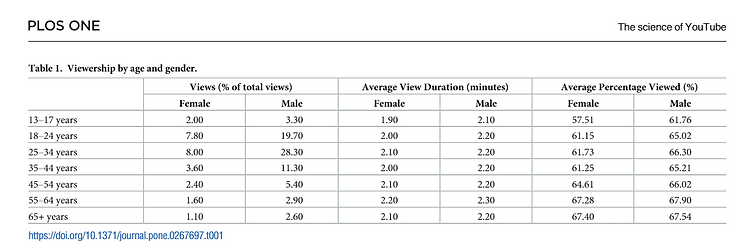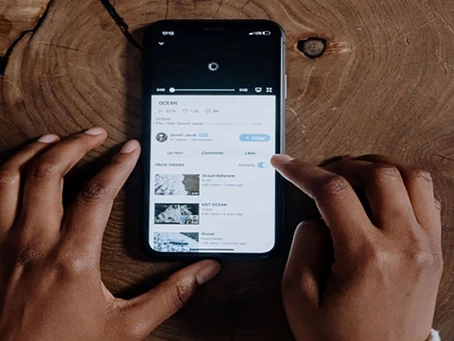Want to know how to get better SciComm Youtube engagement? Like and Subscribe to find out!
By Sarah Ferguson
Title: The science of YouTube: What factors influence user engagement with online science videos?
Author(s) and Year: Shiyu Yang, Dominique Brossard, Dietram A. Scheufele, Mike Xenos 2022
Journal: PLOS One (open access)
TL;DR: Content isn’t the only thing that determines SciComm success on YouTube. Videos that are shorter in length and get more social endorsement (e.g., video likes) are viewed more often.
Why I chose this paper: I have more than one friend with a science YouTube video obsession. I started wondering what makes a SciComm YouTube video successful, beyond the subject matter of the video itself. This paper shows the aspects that can boost a video’s success in YouTube’s algorithm, while cautioning that social media success should never be the end goal of SciComm, but a way to reach more meaningful communication goals.
Introduction
We’ve all done it- kept clicking through the suggested video reel on YouTube until suddenly an hour (or many) has passed. But what makes a video pop up as suggested? And which suggested videos do audiences end up watching and engaging with? For SciCommers interested in breaking into YouTube, the answers to these questions can help hack the algorithm to better science engagement. Luckily, the authors of a 2022 paper titled The science of YouTube: What factors influence user engagement with online science videos? shed some light on how to increase video engagement without changing video content.
The Details
More scientists and science organizations are trying to engage the public directly by creating science-based YouTube videos. Furthermore, science-based educational videos are popular – the genre ranked 7th among video uploads on YouTube in 2017.
Previous science communication studies have determined which kind of video content connects with audiences, but YouTube’s algorithm relies on more than video content when suggesting videos. While a company’s algorithm may be confidential, researchers can still analyze which types of non-content related video characteristics lead to more views to see what the algorithm might be prioritizing. One category of these characteristics is social endorsement. Social endorsement, i.e., liking a video, leaving a comment, adding a video to a playlist, can impact a video’s ranking in an algorithm and in turn impact user engagement behavior, like watching a video all the way through.
Methods
Yang et al. 2022 analyzed data from the American Chemical Society’s science YouTube channel, Reactions, to summarize audience demographics and which social endorsement activities lead to greater video success. Their goal was to find video characteristics that could make a video stand out in an algorithm and thus more likely to reach viewers.
Researchers used statistical regression models to test how strongly a social endorsement variable influenced user engagement behaviors. Variables were tested in groups to see how well they explained a certain user engagement outcome. More and more variables were added to the initial group to see if they strengthened or weakened the connection with user behaviors.
The Results
The most active audience on the Reactions channel were young males (Figure 1). The researchers believe this could be due to two factors. The first being that YouTube’s general audience skews majority male. The second is because there are few videos by women science communicators and scientists on YouTube.

Analysis showed that Reactions channel subscribers were more likely to engage with content, however, the majority of video views came from non-subscribers, indicating that the videos reach beyond their most invested audience. Moreover, audiences watching on mobile phones were more likely to engage in social endorsement behaviors that correlate with user engagement, such as watching an entire video.
Unsurprisingly, number of likes was the social endorsement cue that correlated most strongly with user engagement (Figure 2). Though this finding may seem obvious, the researchers point out that their work examines to what extent video likes matter. They found that having more video likes increased rates of low and high effort engagement behaviors, as well as attention based behaviors.
Video views were also important for influencing user behavior, correlating with increased rates of shares, subscribing and being added to playlists.

The Impact
Reactions’ audience reflects an already science engaged population, but the finding that most video views came from non-subscribers shows the potential for YouTube videos to reach new audiences. However, the realization that most audience members were male highlights that science YouTube channels are not reaching a diverse audience and a future research problem.
As videos by individual users, instead of professionally produced videos, become more popular, this offers the opportunity for creators of diverse genders to produce content that might attract more diverse audience members.
Additionally, identifying the social endorsement cues that correlate with user engagement provides a way to maximize video success without changing content. Learning when audience members are more likely to perform acts of social endorsement, such as while watching on their phones, suggests that science videos should be optimized for viewing on mobile phones. The researchers also speculate that audiences are on their mobile phones during transition times in their day, like while on the bus or while waiting for a meeting to start, so creating shorter videos may give them more time to watch and share videos to others.
Finding more ways to get audiences to socially endorse videos through likes, commenting, sharing, and subscribing could lead to more meaningful engagement and new viewers. However, the researchers caution against chasing social endorsements as a guarantee for better science engagement. For example, high video view count was associated with lower user engagement. Instead, science communicators on YouTube should use social endorsement to meet larger science communication goals rather than making social endorsement the communication goal itself.
Edited by Caroline Cencer and Kay McCallum
Cover image credit: Cottonbro Studio

